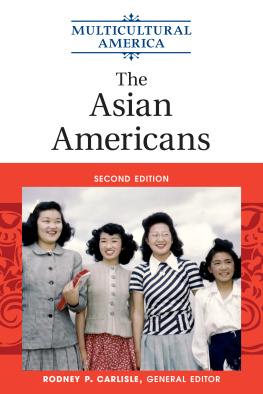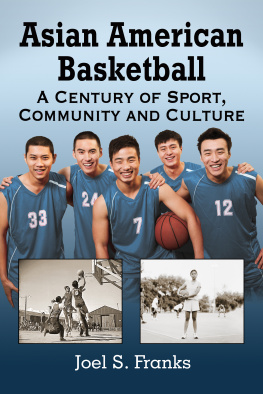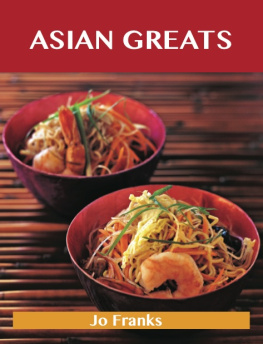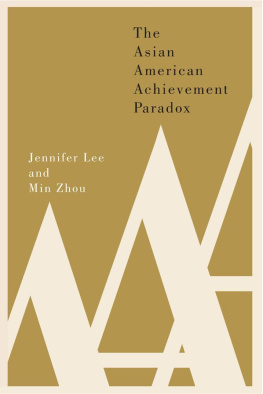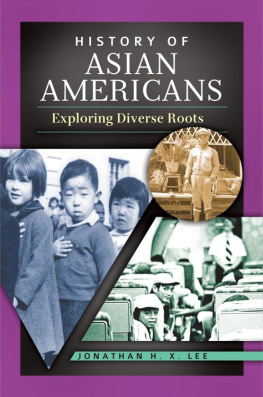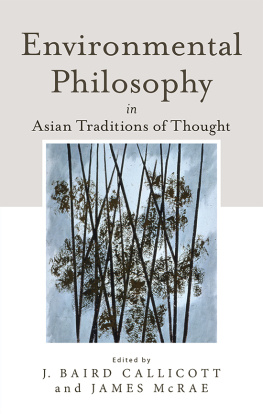Rodney P. Carlisle - The Asian Americans
Here you can read online Rodney P. Carlisle - The Asian Americans full text of the book (entire story) in english for free. Download pdf and epub, get meaning, cover and reviews about this ebook. year: 2017, publisher: Infobase Publishing, genre: Romance novel. Description of the work, (preface) as well as reviews are available. Best literature library LitArk.com created for fans of good reading and offers a wide selection of genres:
Romance novel
Science fiction
Adventure
Detective
Science
History
Home and family
Prose
Art
Politics
Computer
Non-fiction
Religion
Business
Children
Humor
Choose a favorite category and find really read worthwhile books. Enjoy immersion in the world of imagination, feel the emotions of the characters or learn something new for yourself, make an fascinating discovery.
- Book:The Asian Americans
- Author:
- Publisher:Infobase Publishing
- Genre:
- Year:2017
- Rating:5 / 5
- Favourites:Add to favourites
- Your mark:
- 100
- 1
- 2
- 3
- 4
- 5
The Asian Americans: summary, description and annotation
We offer to read an annotation, description, summary or preface (depends on what the author of the book "The Asian Americans" wrote himself). If you haven't found the necessary information about the book — write in the comments, we will try to find it.
Although severely regulated in the 19th century, the emigration of Asian peoples to America has proven to be culturally and socially significant. The diversity of Asian immigrantsa group that includes Koreans, Japanese, Vietnamese, Chinese, Fili
The Asian Americans — read online for free the complete book (whole text) full work
Below is the text of the book, divided by pages. System saving the place of the last page read, allows you to conveniently read the book "The Asian Americans" online for free, without having to search again every time where you left off. Put a bookmark, and you can go to the page where you finished reading at any time.
Font size:
Interval:
Bookmark:
Copyright 2017 by Infobase
All rights reserved. No part of this publication may be reproduced or utilized in any form or by any means, electronic or mechanical, including photocopying, recording, or by any information storage or retrieval systems, without permission in writing from the publisher. For more information, contact:
Facts On File
An imprint of Infobase
132 West 31st Street
New York NY 10001
ISBN 978-1-4381-7031-2
You can find Facts On File on the World Wide Web
at http://www.infobaselearning.com
Americans have had a sense that they were a unique people, even before the American Revolution. In the 18th century, the settlers in the thirteen colonies that became the United States of America began to call themselves Americans, recognizing that they were not simply British colonists living in North America. In addition to the English, other cultures and peoples had already begun to contribute to the rich tapestry that would become the American people.
Swedes and Finns in the Delaware River valley, Dutch in New York, Scots-Irish, and Welsh had all brought their different ways of life, dress, diet, housing, and religions, adding them to the mix of Puritan and Anglican Englishmen. Lower Rhine German groups of dissenting Amish and Mennonites, attracted by the religious toleration of Pennsylvania, settled in Germantown, Pennsylvania, as early as 1685. Located on the western edge of Philadelphia, the settlers and later German immigrants moved to the counties just further west in what would become Pennsylvania Dutch country.
The policies of the other colonies tended to favor and encourage such group settlement to varying extents. In some cases, as in New Jersey, the fact that each community could decide what church would be supported by local taxes tended to attract coreligionists to specific communities. Thus in the colonial period, the counties of southern New Jersey (known in colonial times as West Jersey) tended to be dominated by Quakers. Townships in New Jersey closer to New York City were dominated by Lutheran, Dutch Reformed, and Anglican churches and settlers.
Ethnicity and religion divided the peoples of America, yet the official tolerance of religious diversity spawned a degree of mutual acceptance. While crossreligious marriages were frowned upon, they were not prohibited, with individual families deciding which parents' church should be attended, if any. Modern descendants tracing their ancestry are sometimes astounded at the various strands of culture and religion that they find woven together.
To the south, Florida already had a rich Hispanic heritage, some of it filtered through Cuba. Smaller groups of immigrants from France and other countries in Europe were supplemented during the American Revolution by enthusiastic supporters of the idea of a republican experiment in the New World.
All of the thirteen colonies had the institution of African slavery, and people of African ancestry, both slave and free, constituted as much as 40 percent of the population of colonies like Georgia and South Carolina. In a wave of acts of emancipation, slaves living in the New England colonies were freed right after the Revolution, soon joined by those in Pennsylvania, New York, and New Jersey. Although some African Americans in the south were free by birth or manumission, emancipation for 90 percent of those living south of Pennsylvania would have to wait until the Civil War, 186165. Forcibly captured and transported under terrible conditions overland and across the ocean, Africans came from dozens of different linguistic stocks. Despite the disruptions of the middle passage, African Americans retained elements of their separate cultures, including some language and language patterns, and aspects of diet, religion, family, and music.
Native Americans, like African Americans, found themselves excluded from most of the rights of citizenship in the new Republic. In the Ohio and Mississippi Valley, many Native Americans resisted the advance of the European-descended settlers. In Florida, Creeks and Seminoles provided haven to escaped slaves, and together, they fought the encroachment of settlers. Some of the African Americans living with the Seminoles and other tribes moved west with them on the Trail of Tears to Indian Territory in what later became the state of Oklahoma. Other groups, like the Lumbees of North Carolina, stayed put, gradually adjusting to the new society around them. Throughout scattered rural communities, clusters of biracial and triracial descendents could trace their roots to Native-American and African ancestors, as well as to the English and Scotch-Irish.
The Louisiana Purchase brought the vast Mississippi Valley into the United States, along with the cosmopolitan city of New Orleans, where French exiles from Canada had already established a strong Creole culture. With the annexation of Texas, and following the Mexican-American War (184648), the United States incorporated as citizens hundreds of thousands of people of Hispanic ancestry. Individuals and communities in Texas and New Mexico preserve not only their religion, but also their language, cuisine, customs, and architecture.
As the United States expanded to the west, with vast opportunities for settlement, waves of European immigrants contributed to the growth of the country, with liberal naturalization laws allowing immigrants to establish themselves as citizens. Following the revolutions of 1848 in Europe, and famines in Ireland, new floods of immigrants from Central Europe, Ireland, and Scandinavia all settled in pockets.
By the late 19th century, America had become a refuge for political and economic refugees, as well as enterprising families and individuals from many countries. More geographic-ethnic centers emerged, as new immigrants sought out and settled near friends and families who had already arrived. Neighborhoods and whole states took on some aspects of the ethnic cultures that the immigrants carried, with the Italians settling in New York City, San Francisco, and New Jersey; Azoreans and continental Portuguese in Rhode Island and southern Massachusetts; Scandinavians in Wisconsin and Minnesota; Germans in Missouri; and Chinese and Japanese in a number of West Coast cities and towns. San Francisco and Boston became known for their Irish settlers, and Italians joined Franco-Hispanic Catholics of New Orleans. In some other scattered communities, such as the fishing port of Monterey, California, later Portuguese and Italian arrivals were also absorbed into the local Hispanic community, partly through the natural affinity of the shared Catholic faith.
As waves of immigrants continued to flow into the United States from the 1880s to World War I, the issue of immigration became even more politicized. On the one hand, older well-established ethnic communities sometimes resented the growing influence and political power of the new immigrants. Political machines in the larger cities made it a practice to incorporate the new settlers, providing them with some access to the politics and employment of city hall, also expecting their votes and loyalty during election. The intricate interplay of ethnicity and politics through the late 19th century has been a rich field of historical research.
In the 1890s the United States suddenly acquired overseas territories, including Hawaii, Puerto Rico, and Guam. People from the new territories became American citizens, and although the great majority of them did not leave their islands, those who came to the continental United States became part of the increasingly diverse population. The tapestry of American culture and ancestry acquired new threads of Polynesian, Asian, Hispanic, and African-Hispanic people.
During the Progressive Era, American-born citizens of a liberal or progressive political inclination often had mixed feelings about immigrants. Those with a more elite set of values believed that crime, alcoholism, and a variety of vices running from drug abuse through prostitution, gambling, and underground sports such as cockfighting, all could be traced to the new immigrants. The solution, they believed, would be immigration reform: setting quotas that would restrict immigrants from all but Great Britain and northern Europe.
Font size:
Interval:
Bookmark:
Similar books «The Asian Americans»
Look at similar books to The Asian Americans. We have selected literature similar in name and meaning in the hope of providing readers with more options to find new, interesting, not yet read works.
Discussion, reviews of the book The Asian Americans and just readers' own opinions. Leave your comments, write what you think about the work, its meaning or the main characters. Specify what exactly you liked and what you didn't like, and why you think so.

